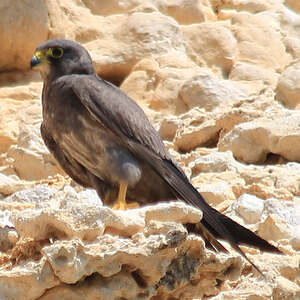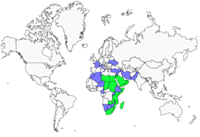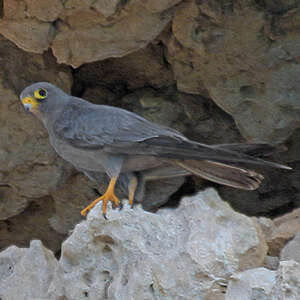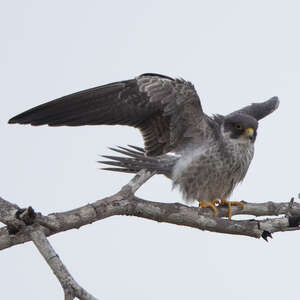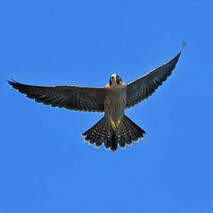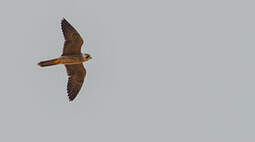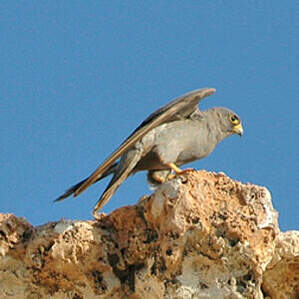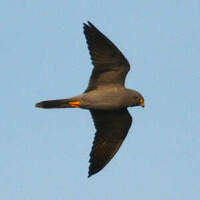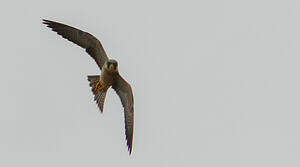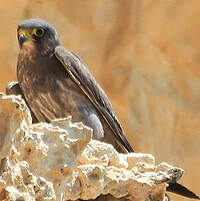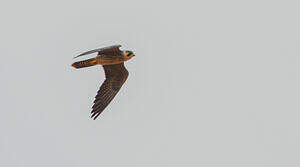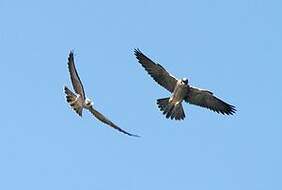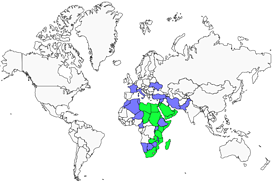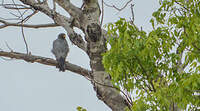Sooty Falcon
Falco concolor - Faucon concolore
Identification
The adult Sooty Falcon is a small to medium-sized falcon, with an all-gray plumage and a slim silhouette caused by its long and pointed wings and long tail. In direct sunlight, which is often the case in its breeding areas, the body appears light gray and bluish, somewhat similar to the African Tached Falcon. It is only up close that the darker centers of the gray feathers of the body and wing coverts become visible. In bad light, it looks darker and could be confused with other falcons. Remiges and rectrices are blackish and solid, creating a strong contrast with the gray body. A good identifying criterion for the adults in flight is the shape of the tail: the central rectrices are slightly longer than the others. The eye ring, the bare skin around the eye, the waxy color of the beak and the legs are yellow-lemon. The eye is dark. The beak is blue-gray with a dark tip.
The juvenile has a very different aspect and resembles a young Peregrine. It is ash-gray on top with russet edgings on the cover feather. The underside is whitish-russet, largely spotted with dark gray. This aspect comes from the bicolored character of each tectrix, gray in the center and largely edged with russet. The head is hooded with blackish, with wide mustaches reminiscent of the Peregrine. The hood contrasts with the creamy-russet throat, the lower cheeks, and the sides of the neck. Remiges and rectrices are barred with light. The bare parts are very pale yellow-green. Finally, its silhouette is less thin than the one of the adult.
The adult Sooty Falcon can be confused with other gray falcons, for example the already mentioned African Tached Falcon. However, the latter is smaller, more massive in appearance, of a more uniform gray and with identical rectrices.The Sooty Falcon of Eleonora's Moth is slightly larger and much darker, with a sooty-blackish-gray. It frequents the same wintering grounds. The male adult Kobez Falcon is a bluish-slate-gray and shows an inverse contrast to the Sooty Falcon, with remiges and rectrices appearing paler than the rest of the bird. Furthermore, its bare parts are a bright orange. The juvenile Sooty Falcon is more delicate to distinguish from that of other species and should take note of the criteria mentioned above. The species most closely resembling it is the young Love Falcon.
Subspecific information monotypic species
Foreign names
- Faucon concolore,
- Halcón pizarroso,
- falcão-uniforme,
- Schieferfalke,
- hamvas sólyom,
- Woestijnvalk,
- Falco unicolore,
- sotfalk,
- Sotfalk,
- sokol bridlicový,
- ostříž arabský,
- Sodfalk,
- nokihaukka,
- Roetvalk,
- falcó fumat,
- Skuggafálki,
- sokół śniady,
- tumšais piekūns,
- sajasti sokol,
- Серебристый чеглок,
- ウスズミハヤブサ,
- 烟色隼,
- 煙隼,
Voice song and cries
Habitat
During the breeding season, the Sooty Falcon frequents very arid and vegetationless, but rugged areas.
In its wintering zone, it chooses more humid, and insect rich areas, open woodlands, wetlands, rice fields, and tree-bearing savannahs that are suitable for predation activities.
Behaviour character trait
This is a fairly gregarious and sociable species. During the breeding period, in very favorable places like the Red Sea islands, nests may be a few tens of meters away from each other, while in inland sites, this distance is rather measured in hundreds of kilometers.
This is therefore not a colonial species. In its winter quarters, it can be observed in small groups of a few individuals.Sooty Falcons are long-distance migrants. From mid-October, as soon as the young are emancipated, they set off towards Southeast Africa. Their main destination is Madagascar where they stay until the end of April or the beginning of May. At that date, they embark on the return journey to their breeding grounds.
The Sooty Falcon is fairly discreet and silent, except at the time of reproduction.
Flight
Dietfeeding habits
The Sooty Falcon is a specialized aviphage during the breeding season. Its breeding coincides with the peak passage of small migrating birds heading to Africa via the eastern route, with which it feeds its nest.
Due to its size, it mostly feeds on birds up to the size of bee-eaters, which itself is an abundant and early migrant. Particularly active at dawn and dusk, it also attacks nocturnal migrants and bats.In its winter quarters, it mainly becomes an insectivore like other small falcons such as the Eleonora's Falcon or the Hobby Falcon. These are flying insects such as dragonflies, crickets or termites which it actively hunts on the wing like a hobby or which it watches from a perch such as a dead tree before launching into them with a direct and fast flight. In case of concentrations of flying insects such as termite swarms, several individuals can be seen hunting together.
Reproduction nesting
The breeding period of the Sooty Falcon is delayed compared to most other birds in its occupied area.
Clutching usually occurs in June or July, so the raising of the young in the nest is pushed back to August-September, which coincides with the post-nuptial peak of passage of many small migrating birds, mostly passerines, but also non-passerines such as swallows or bee-eaters. The nests are usually located in crevices or holes in the upper part of cliffs, but sometimes they can also be set on rocky outcrops or corals or on ground level under thickets. It may also reuse old nests of other species. The female lays two or three eggs and incubation lasts between 27 and 30 days. The female brood most of the time, while the male is solely responsible for feeding until the chicks reach two weeks old. The stay in the nest is 32-38 days and the young become independent at 6-7 weeks. It seems that some reach sexual maturity in their second year of life.Geographic range
The Sooty Falcon is a species found in the northeast of Africa (inland Libya and Egypt), around the Red Sea, along the Arabian Peninsula in the south of the Persian Gulf and the Gulf of Oman and beyond to the coast of Pakistan. Two good places to observe this species are the Egyptian coast near Hurghada and the north coast of Oman.
It mainly takes its winter quarters to Madagascar, then in southern Africa along the Mozambique Coast and South Africa, with incursions inland and to the islands between Madagascar and the continent.
During its migration, it visits all the countries bordering the Indian Ocean such as Ethiopia, Kenya and Tanzania, where it stops.
Threats - protection
IUCN conservation status
concern
in the Wild
threatened
evaluated
The population level is poorly known. It is estimated to be between 15,000 and 30,000 birds; which speaks to the level of uncertainty. It is thought that the population of the Sooty Falcon is declining, but this decline has not been well documented. There is one factor working against it, which is its low reproductive rate estimated at 1 or 2 fledglings per nest.
Sources of information
- IOC World Bird List (v14.1), Gill, F and D Donsker (Eds). 2024-04-18.
- HBW Alive,
Other sources of interest
 Specification sheet created on
28/10/2023 by Daniel Le-Dantec
Specification sheet created on
28/10/2023 by Daniel Le-Dantec partially rewritten on 00/00/0000 by Jean François
Translation by AI Oiseaux.net
published: 31-08-2005 - Updated: 09-03-2017
© 1996-2024 Oiseaux.net
- Accipitriformes
- Aegotheliformes
- Anseriformes
- Apodiformes
- Apterygiformes
- Bucerotiformes
- Caprimulgiformes
- Cariamiformes
- Casuariiformes
- Charadriiformes
- Ciconiiformes
- Coliiformes
- Columbiformes
- Coraciiformes
- Cuculiformes
- Eurypygiformes
- Falconiformes
- Galliformes
- Gaviiformes
- Gruiformes
- Leptosomiformes
- Mesitornithiformes
- Musophagiformes
- Nyctibiiformes
- Opisthocomiformes
- Otidiformes
- Passeriformes
- Pelecaniformes
- Phaethontiformes
- Phoenicopteriformes
- Piciformes
- Podargiformes
- Podicipediformes
- Procellariiformes
- Psittaciformes
- Pterocliformes
- Rheiformes
- Sphenisciformes
- Steatornithiformes
- Strigiformes
- Struthioniformes
- Suliformes
- Tinamiformes
- Trogoniformes

